Simplified Heat and Mass Transfer Model for Cross-Flow and Countercurrent Flow Packed Bed Tower Dehumidifiers with a Liquid Desiccant System
Abstract
:1. Introduction
- The effectiveness of different types of LAMEEs for air cooling and dehumidifying was between 60% and 94%.
- The effectiveness of a flat-plate LAMEE in summer operating conditions is higher than in winter operating conditions.
- The performance of LAMEEs can be significantly reduced if there is flow maldistribution.
- On the air and liquid sides hollow-fiber LAMEEs endure large pressure drops.
2. Physical Properties of the Desiccant
3. Theoretical Model
3.1. Counter-Flow Dehumidifier
3.1.1. Governing Equation
- (1)
- Humid air is the mixture of an ideal gas, and Dalton’s law of partial pressures is true [35].
- (2)
- One-dimensional transient heat and mass transfer are considered [36].
- (3)
- Air flow is uniform [37].
- (4)
- Constant specific heat capacities are for dry air and liquid desiccant.
- (5)
- Compared with the gas phase, the liquid phase neglects thermal resistance.
- (6)
- The surroundings have no heat exchange; and
- (7)
- Liquid desiccant neglects vaporization.
3.1.2. Non-Dimensional Formulation
3.2. Cross-Flow Dehumidifier
3.2.1. Governing Equation
- (1)
- The heat and mass transfer can be simplified to a two-dimensional analysis.
- (2)
- The air and liquid desiccant uniformly enter the dehumidifier.
3.2.2. Non-Dimensional Formulation
3.3. Orthogonal Collocation Method
4. Results and Discussion
4.1. Countercurrent Flow
4.2. Cross-Flow
5. Conclusions
Acknowledgments
Author Contributions
Conflicts of Interest
Nomenclature
| A | heat and mass transfer area (m2) |
| cp,m | specific heat of humid air (J·kg−1·K−1) |
| H | total height of dehumidifier (m) |
| dimensionless enthalpy (dimensionless) | |
| h | height of dehumidifier (m) |
| he | enthalpy(kJ·kg−1) |
| L | length (m) |
| Le | Lewis number (dimensionless) |
| dimensionless mass flow rate (dimensionless) | |
| mass flow rate(kg·h−1) | |
| NTUm | dimensionless number of mass transfer unit (dimensionless) |
| r | vaporization latent heat (kJ·kg−1) |
| t | time (s) |
| v | air velocity (m·s−1) |
| dimensionless humidity ratio (dimensionless) | |
| X | desiccant solution concentration (kgLiCl·kgsolution−1) |
| dimensionless desiccant solution concentration (dimensionless) | |
| z | packing height (m) |
| Greek symbols | |
| α | heat transfer coefficient(W·m−2·°C−1) |
| αm | Mass transfer coefficient(m·s−1) |
| ω | humidity ratio (g·kg−1) |
| water concentration in liquid desiccant (%) | |
| Subscripts | |
| a | air |
| e | air in equilibrium with solution desiccant |
| i | initial condition |
| o | original condition |
| s | solution desiccant |
References
- Feyka, S.; Vafai, K. An investigation of a falling film desiccant dehumidification/regeneration cooling system. Heat Transf. Eng. 2007, 28, 163–172. [Google Scholar] [CrossRef]
- Jain, S.; Bansal, P.K. Performance analysis of liquid desiccant dehumidification systems. Int. J. Refrig. 2007, 30, 861–872. [Google Scholar] [CrossRef]
- Oberg, V.; Goswami, D.Y. Experimental study of the heat and mass transfer in a packed bed liquid desiccant air dehumidifier. J. Sol. Energy Eng. Trans. ASME 1998, 120, 289–297. [Google Scholar] [CrossRef]
- Miao, R.S. Study of Alternative Liquid Absorbents Using a Thermodynamic Model and a Combined Physico-Optical Method. Ph.D. Thesis, Department of Mechanical Engineering, University of Illinois at Chicago, Chicago, IL, USA, 1997. [Google Scholar]
- Waugaman, D.G.; Kini, A.; Kettleborough, C.F. A review of desiccant cooling systems. J. Energy Resour. Technol.-Trans. ASME 1993, 115, 1–8. [Google Scholar] [CrossRef]
- Jain, S.; Dhar, P.L.; Kaushik, S.C. Evaluation of liquid desiccant based evaporative cooling cycles for typical hot and humid climates. Heat Recovery Syst. CHP 1994, 14, 621–632. [Google Scholar] [CrossRef]
- Kessling, W.; Laevemann, E.; Kapfhammer, C. Energy storage for desiccant cooling systems component development. Sol. Energy 1998, 64, 209–221. [Google Scholar] [CrossRef]
- Liu, X.H.; Zhang, Y.; Qu, K.Y.; Jiang, Y. Experimental study on mass transfer performances of cross flow dehumidifier using liquid desiccant. Energy Convers. Manag. 2006, 47, 2682–2692. [Google Scholar] [CrossRef]
- Liu, X.H.; Jiang, Y.; Chang, X.M.; Yi, X.Q. Experimental investigation of the heat and mass transfer between air and liquid desiccant in a cross-flow regenerator. Renew. Energy 2007, 32, 1623–1636. [Google Scholar] [CrossRef]
- Fumo, N.; Goswami, D.Y. Study of an aqueous lithium chloride desiccant system: Air dehumidification and desiccant regeneration. Sol. Energy 2002, 72, 351–361. [Google Scholar] [CrossRef]
- Gommed, K.; Grossman, G. Experimental investigation of a liquid desiccant system for solar cooling and dehumidification. Sol. Energy 2007, 81, 131–138. [Google Scholar] [CrossRef]
- Zhang, L.; Hihara, E.; Matsuoka, F.; Dang, C. Experimental analysis of mass transfer in adiabatic structured packing dehumidifier/regenerator with liquid desiccant. Int. J. Heat Mass Transf. 2010, 53, 2856–2863. [Google Scholar] [CrossRef]
- Mohammad, A.T.; Mat, S.B.; Sulaiman, M.Y.; Sopian, K.; Al-Abidi, A.A. A Statistical Analysis of a Liquid Desiccant Dehumidifier/Regenerator in an Air Conditioning System. Int. J. Therm. Environ. Eng. 2013, 5, 41–50. [Google Scholar]
- Bassuoni, M.M. An experimental study of structured packing dehumidifier/regenerator operating with liquid desiccant. Energy 2011, 36, 2628–2638. [Google Scholar] [CrossRef]
- Park, J.Y.; Jeong, J.W. A simplified model for predicting dehumidification effectiveness of a liquid desiccant system. In Proceedings of the AEI 2013: Building Solutions for Architectural Engineering, State College, PA, USA, 3–5 April 2013; pp. 516–523.
- Babakhani, D. Analytical approach based on a mathematical model of an air dehumidification process. Br. J. Chem. Eng. 2013, 30, 793–799. [Google Scholar] [CrossRef]
- Wassan, M.A.; Habib, K.; Hassan, S. Mathematical Modelling and Simulation of the Dehumidifier for the Tropical Region of Malaysia. In Proceedings of the IEEE Engineering and Industrial Applications Colloquium (BEIAC), Langkawi, Malaysia, 7–9 April 2013; pp. 795–800.
- Rahimi, A.; Babakhani, D. Mathematical modeling of a packed-bed air dehumidifier: The impact of empirical correlations. J. Pet. Sci. Eng. 2013, 108, 222–229. [Google Scholar] [CrossRef]
- Onda, K.; Takeuchi, H.; Okumoto, Y. Mass transfer coefficients between gas and liquid phases in packed columns. J. Chem. Eng. Jpn. 1968, 1, 56–62. [Google Scholar] [CrossRef]
- Rocha, J.A.; Bravo, J.L.; Fair, J.R. Distillation columns containing structured packings: A comprehensive model for their performance. 2. Mass-transfer model. Ind. Eng. Chem. Res. 1996, 35, 1660–1667. [Google Scholar] [CrossRef]
- Treybal, R.E. Mass Transfer Operations; McGraw-Hill: New York, NY, USA, 1981. [Google Scholar]
- Chung, T.W.; Ghosh, T.K.; Hines, A.L. Comparison between Random and Structured Packings for Dehumidification of Air by Lithium Chloride Solutions in a Packed Column and Their Heat and Mass Transfer Correlations. Ind. Eng. Chem. Res. 1996, 35, 192–198. [Google Scholar] [CrossRef]
- Kumar, R.; Asati, A.K. Simplified Mathematical Modelling of Dehumidifier and Regenerator of Liquid Desiccant System. Int. J. Curr. Eng. Technol. 2014, 4, 557–563. [Google Scholar]
- Niu, R.P. Modeling and Numerical Simulation of Dehumidifier Using LiCl Solution as the Liquid Desiccant. Adv. Mater. Res. 2012, 383–390, 6568–6573. [Google Scholar] [CrossRef]
- Bassuoni, M.M. Analytical Modeling and Performance Study of a Cross Flow Air Dehumidifier Using Liquid Desiccant. Adv. Mater. Res. 2014, 875–877, 1205–1213. [Google Scholar] [CrossRef]
- Bassuoni, M.M. A simple analytical method to estimate all exit parameters of a cross-flow air dehumidifier using liquid desiccant. J. Adv. Res. 2014, 5, 175–182. [Google Scholar] [CrossRef] [PubMed]
- Lu, H.; Lu, L.; Luo, Y.M.; Qi, R.H. Investigation on the dynamic characteristics of the counter-current flow for liquid desiccant dehumidification. Energy 2016, 101, 229–238. [Google Scholar] [CrossRef]
- Abdel-Salam, M.R.H.; Fauchoux, M.; Ge, G.; Besant, R.W.; Simonson, C.J. Expected energy and economic benefits, and environmental impacts for liquid-to-air membrane energy exchangers (LAMEEs) in HVAC systems: A review. Appl. Energy 2014, 127, 202–218. [Google Scholar] [CrossRef]
- Ge, G.; Abdel-Salam, M.R.H.; Besant, R.W.; Simonson, C.J. Research and applications of liquid-to-air membrane energy exchangers in building HVAC systems at university of Saskatchewan: A review. Renew. Sustain. Energy Rev. 2013, 26, 464–479. [Google Scholar] [CrossRef]
- Bergero, S.; Chiari, A. Experimental and theoretical analysis of air humidification/dehumidification processes using hydrophobic capillary contactors. Appl. Therm. Eng. 2001, 21, 1119–1135. [Google Scholar] [CrossRef]
- Zhang, L.Z. An analytical solution to heat and mass transfer in hollow fiber membrane contactors for liquid desiccant air dehumidification. Trans. ASME J. Heat Transf. 2011, 133, 1–8. [Google Scholar] [CrossRef]
- Abdel-Salam, M.R.H.; Ge, G.; Fauchoux, M.; Besant, R.W.; Simonson, C.J. State-of-the-art in liquid-to-air membrane energy exchangers (LAMEEs): A comprehensive review. Renew. Sustain. Energy Rev. 2014, 39, 700–728. [Google Scholar] [CrossRef]
- Abdel-Salam, M.R.H.; Besant, R.W.; Simonson, C.J. Sensitivity of the performance of a flat-plate liquid-to-air membrane energy exchanger (LAMEE) to the air and solution channel widths and flow maldistribution. Int. J. Heat Mass Transf. 2015, 84, 1082–1100. [Google Scholar] [CrossRef]
- Ge, G.; Abdel-Salam, A.; Abdel-Salam, M.R.; Besant, R.; Simonson, C. Heat and mass transfer performance comparison between a direct-contact liquid desiccant packed bed and a liquid-to-air membrane energy exchanger for air dehumidification. Sci. Technol. Built Environ. 2016. [Google Scholar] [CrossRef]
- Ruivo, C.R.; Costa, J.J.; Figueiredo, A.R. On the validity of lumped capacitance approaches for the numerical prediction of heat and mass transfer in desiccant airflow systems. Int. J. Therm. Sci. 2008, 47, 282–292. [Google Scholar] [CrossRef]
- Mandegari, M.A.; Pahlavanzadeh, H.; Farzad, S. Energy approach analysis of desiccant wheel operation. Energy Syst. 2014, 5, 551–569. [Google Scholar] [CrossRef]
- Xu, X.Y.; Paschke, S.; Repke, J.U.; Yuan, J.Q.; Wozny, G. Computational approach to characterize the mass transfer between the counter-current gas-liquid flow. Chem. Eng. Technol. 2009, 32, 1227–1235. [Google Scholar] [CrossRef]
- Peng, S.W.; Pan, Z.M. Heat and mass transfer in liquid desiccant air-conditioning process at low flow conditions. Commun. Nonlinear Sci. Numer. Simul. 2009, 14, 3599–3607. [Google Scholar] [CrossRef]
- Pesaran, A.A. Heat and Mass Transfer Analysis of a Desiccant Dehumidifier Matrix; Solar Energy Research Institute: Golden, CO, USA, 1986. [Google Scholar]
- Khan, A.Y.; Ball, H.D. Development of a generalized model for performance evaluation of packed-type liquid sorbent dehumidifiers and regenerators. ASHRAE Trans. 1992, 98, 525–533. [Google Scholar]
- Li, C.Z.; Jiang, Y.; Qu, K.Y. Analytical solution of adiabatic heat and mass transfer process in packed-type liquid desiccant equipment and its application. Sol. Energy 2006, 80, 1509–1516. [Google Scholar]
- Diaz, G. Numerical investigation of transient heat and mass transfer in a parallel-flow liquid-desiccant absorber. Heat Mass Transf. 2010, 46, 1335–1344. [Google Scholar] [CrossRef]
- Hammad, M.M.; El-Ghanam, R.I.; Sakr, R.Y.; Ayad, S.S. Theoretical study for compact liquid desiccant dehumidifier/regenerator system. In Proceedings of the Al/Azhar Engineering Tenth International Conference, Cairo, Egypt, 24–26 December 2008; Volume 3, pp. 352–378.
- Lin, C.; Qun, C.; Zhen, L.; Yuan, G.Z. Moisture transfer resistance method for liquid desiccant dehumidification analysis and optimization. Chin. Sci. Bull. 2010, 55, 1445–1453. [Google Scholar]
- Cizniar, M.; Salhi, D.; Fikar, M.; Latif, M.A. A Matlab package for orthogonal collocations on the finite elements in dynamic optimization. In Proceedings of the 15th International Conference Process Control, Strbské Pleso, Slovakia, 7–10 June 2005.
- Villadsen, J.V.; Stewart, W.E. Solution of boundary-value problems by orthogonal collocation. Chem. Eng. Sci. 1967, 22, 1483–1501. [Google Scholar] [CrossRef]
- Abdel-Salam, M.R.H.; Besant, R.W.; Simonson, C.J. Design and testing of a novel 3-fluid liquid-to-air membrane energy exchanger (3-fluid LAMEE). Int. J. Heat Mass Transf. 2016, 92, 312–329. [Google Scholar] [CrossRef]
- Abdel-Salam, M.R.H.; Besant, R.W.; Simonson, C.J. Performance testing of a novel 3-fluid liquid-to-air membrane energy exchanger (3-fluid LAMEE) under desiccant solution regeneration operating conditions. Int. J. Heat Mass Transf. 2016, 95, 773–786. [Google Scholar] [CrossRef]
- Abdel-Salam, M.R.H.; Ge, G.; Besant, R.; Simonson, C. Experimental study of effects of phase change energy and operating parameters on performances of two-fluid and three-fluid liquid-to-air membrane energy exchangers. ASHRAE Trans. 2016, 122, 134–145. [Google Scholar]
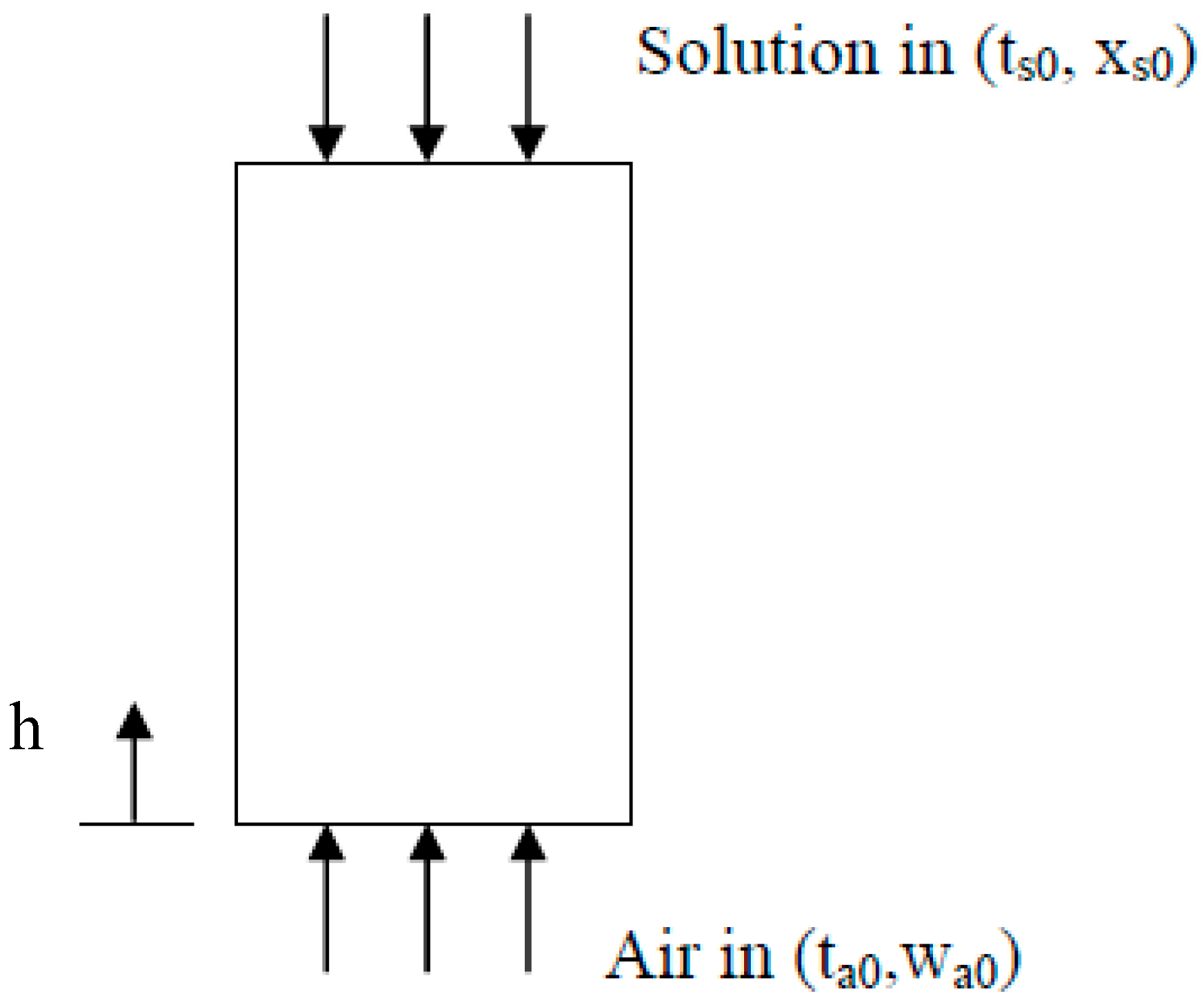
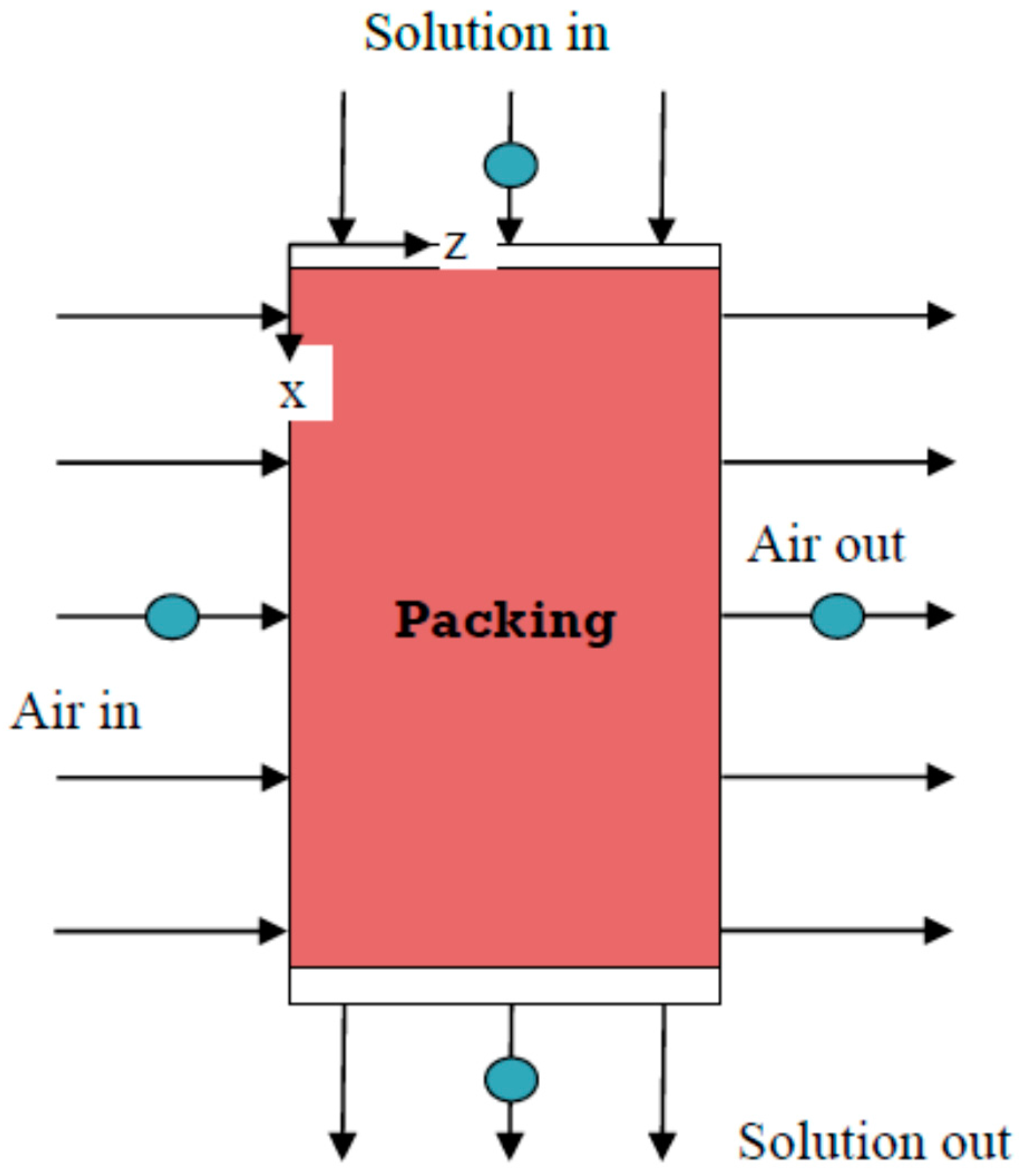
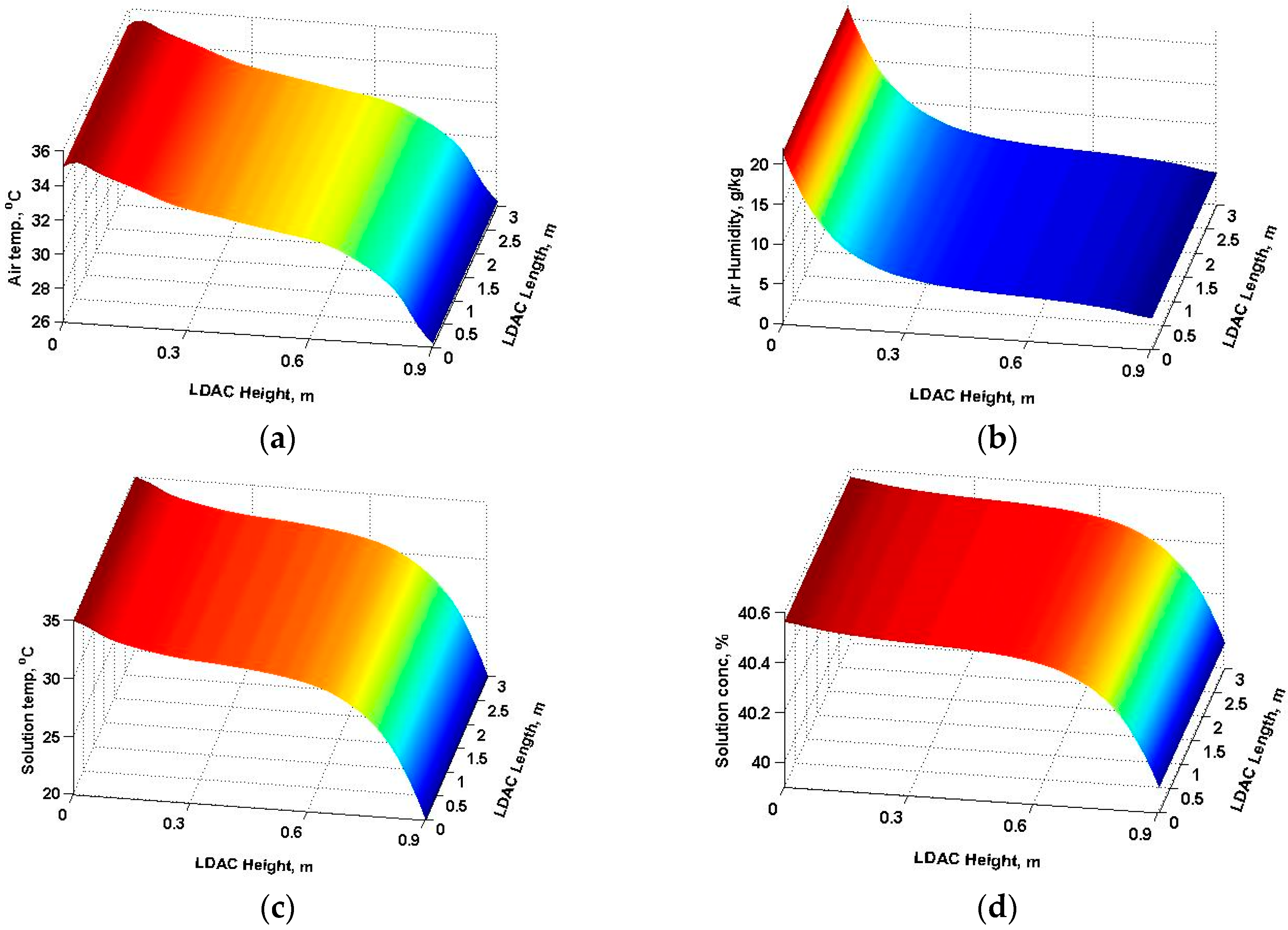
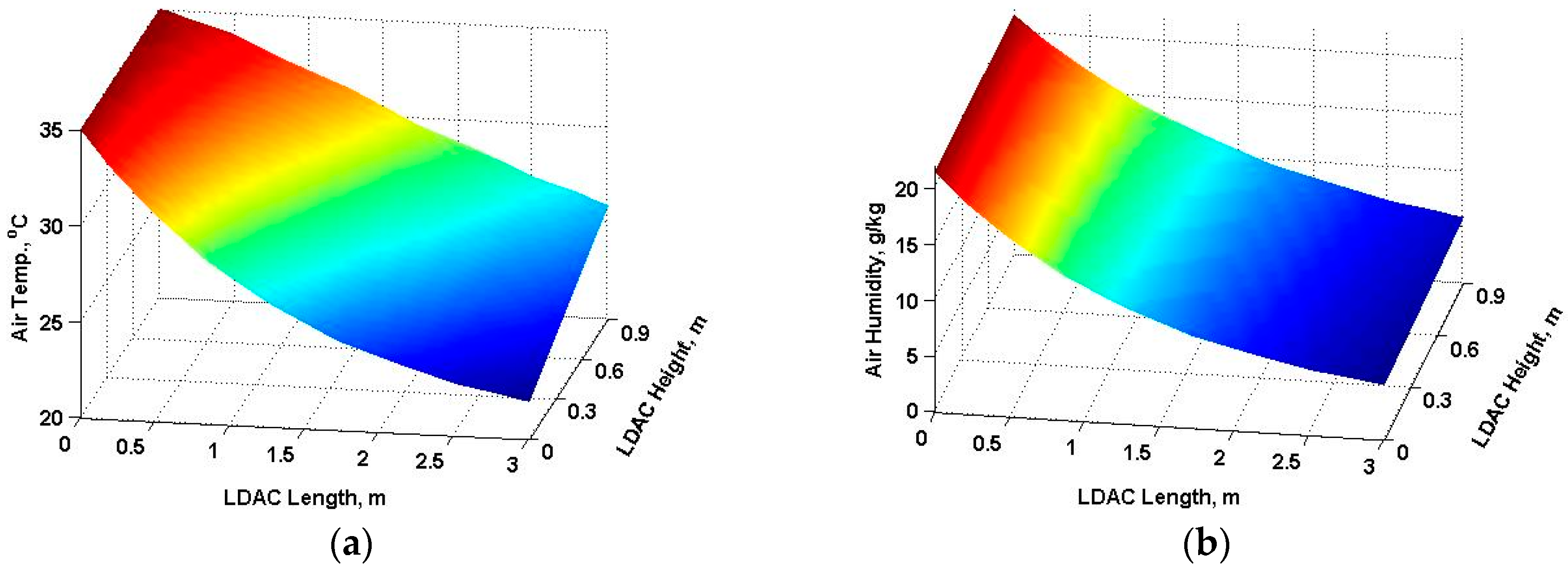
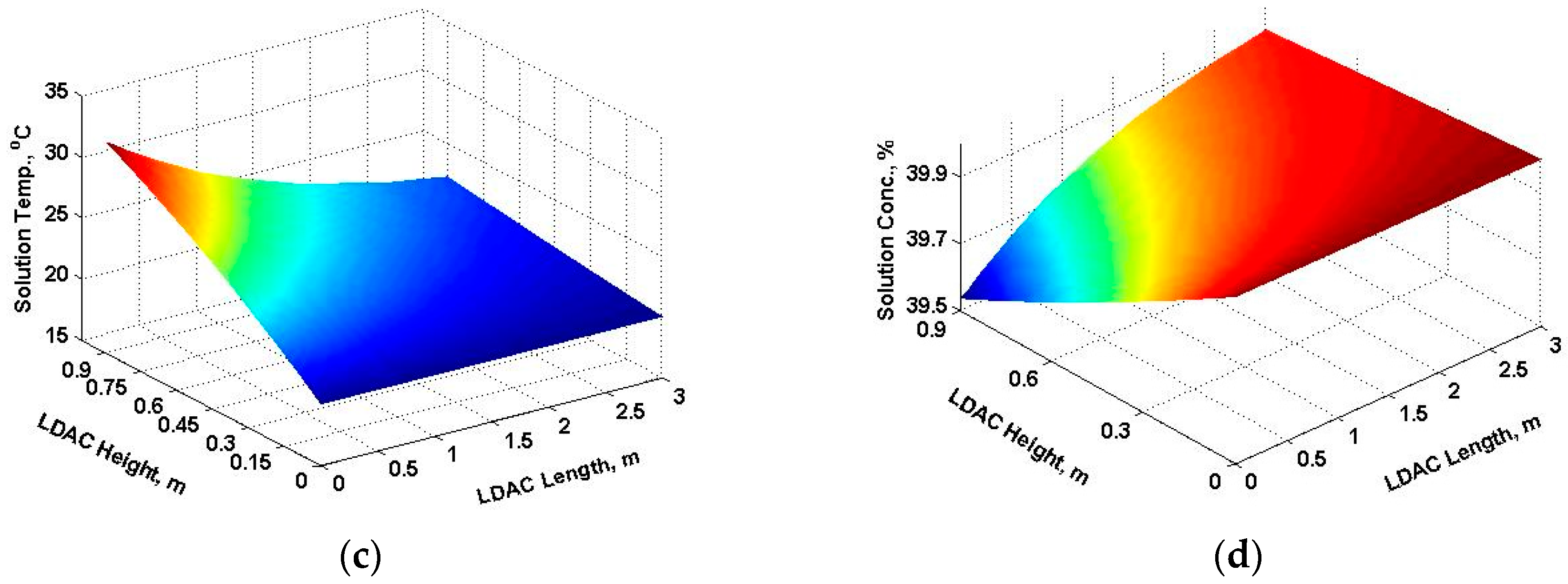
| ρ (kg·m−3) | μ (kg·m−1·s−1) | σ (N·m−1) | θw (°) | |
|---|---|---|---|---|
| LiCl solution | 1180 | 0.00342 | 0.0891 | 65 |
| inlet air temperature (°C) | 27 | |||
| inlet air humidity ratio (g·kg−1) | 18 | |||
| air mass flow rate (kg·h−1) | 25 | |||
| desiccant solution mass flow rate (kg·h−1) | 10 | |||
| inlet desiccant solution equivalent concentration (%) | 40 | |||
| NTU | 1–4 |
|---|---|
| NTUm | 0.37–0.67 |
| bed dimensions | 1.35 m (L) × 1 m (W) × 2.3 m (H) |
| material | Fiberglass reinforced plastic |
| geometry | cuboid |
| porosity of packing | 35% |
© 2016 by the authors; licensee MDPI, Basel, Switzerland. This article is an open access article distributed under the terms and conditions of the Creative Commons Attribution (CC-BY) license (http://creativecommons.org/licenses/by/4.0/).
Share and Cite
Hu, S.-C.; Shiue, A.; Chiu, Y.-S.; Wang, A.; Chen, J. Simplified Heat and Mass Transfer Model for Cross-Flow and Countercurrent Flow Packed Bed Tower Dehumidifiers with a Liquid Desiccant System. Sustainability 2016, 8, 1264. https://doi.org/10.3390/su8121264
Hu S-C, Shiue A, Chiu Y-S, Wang A, Chen J. Simplified Heat and Mass Transfer Model for Cross-Flow and Countercurrent Flow Packed Bed Tower Dehumidifiers with a Liquid Desiccant System. Sustainability. 2016; 8(12):1264. https://doi.org/10.3390/su8121264
Chicago/Turabian StyleHu, Shih-Cheng, Angus Shiue, Yi-Shiung Chiu, Archy Wang, and Jacky Chen. 2016. "Simplified Heat and Mass Transfer Model for Cross-Flow and Countercurrent Flow Packed Bed Tower Dehumidifiers with a Liquid Desiccant System" Sustainability 8, no. 12: 1264. https://doi.org/10.3390/su8121264





